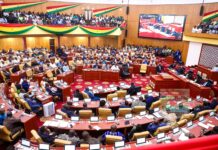
A ranking member on the Mines and Energy Committee of parliament, John Jinapor, has described as highfalutin, the government’s introduced tax reliefs.
Speaking on Joy FM’s Top Story on Wednesday, November 15, he said the reliefs would not bring about any significant changes.
“They are talking of so-called electric vehicles for public sector transport. People are suffering today, inflation is at 38%, the currency is depreciated by more than 20%, you are increasing people’s wages by just 23%, so already you are worse off and instead of coming up with policies that will address the situation now, you come up with this so-called highfalutin reliefs and claim that these are reliefs, to who?” he asked.
This comes after the Finance Minister, Ken Ofori-Atta during his presentation of the 2024 Budget Statement in Parliament on Wednesday announced some measures to cushion Ghanaians.
Some reliefs prioritised by the government include the extension of the zero rates of VAT on locally manufactured African prints, sanitary pads and locally assembled vehicles, as well as waivers on import duties for electric vehicles and agricultural machinery.
To address environmental concerns, Mr Ofori-Atta announced the government’s plan to expand the Environmental Excise Duty to cover plastic packaging, industrial emissions, and vehicle emissions.
“Mr. Speaker, the Stamp Duty Act, 2005 (Act 689) has not been reviewed since its enactment in 2005. To realign the rate with current economic realities, Government, in 2024, will review the rates and fees for stamp duties. The bands subject to ad valorem taxes will be expanded while the specific rates will be reviewed upwards,” he added.
According to Mr Jinapor, the waiver of import duties on electric vehicles “is nothing but a so-called vehicle luxury tax disguised and reintroduced.”
He said the plans of the Finance Minister and the government are just to meet the International Monetary Fund’s (IMF) conditionality “which states that eventually, we should have an 18% tax revenue at the percentage of GDP.”
ALSO READ:





